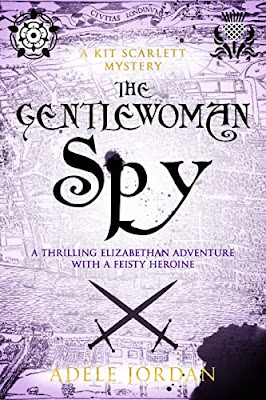Join Kit in a thrilling historical espionage novel! What happens when the spymaster’s right-hand man turns out to be a woman…?
The Women that Inspired Kit Scarlett
A churlish reader once asked me, ‘Surely women from the past don’t have many stories to tell?’ This was a question posited which as you can well imagine, left me dumbstruck and finding it difficult to pick my jaw back up off the floor. Not only is the past full of women’s stories that are yet to be heard, but they can truly dazzle. Perhaps it’s not always so easy to hear women’s voices in a world where men had most ruling positions and wrote the written records, but the voices can be found, if we take the time to look for them.
As a result, I would like to introduce you to three such women’s tales who have inspired me. In their own way, each of these women from the Renaissance helped to create Kit Scarlett, the protagonist of my debut book, ‘The Gentlewoman Spy.’ Whether you agree with them, or question some of their choices, it cannot be denied they lived fascinating lives, and certainly have a story of their own to tell about their clandestine activities.
‘The Wicked Lady’ – Katherine Ferrers (1634 – c. 1660)
This seventeenth century woman, sometimes coined ‘The Wicked Lady’ is somewhat enshrouded in myth and legend. To some extent, who knows where the line between fact and fiction sits, but the real woman gave life to this myth, and has enthralled people for centuries. A female highway robber, or highwaywoman, if you prefer, it’s said she attacked travellers in Hertfordshire with her accomplices before dying of gunshot wounds in a robbery. Clad in men’s clothes and leaving her fine gowns at home in the manor she owned, Katherine led something of a double life.
This is the myth. As for the known facts, they paint the picture of a woman who grew up without much of a steady home, or guiding parents, who might have been left much to her own devices.
Born into a wealthy protestant family, Katherine’s family home was Markyate Cell, now known as Cell Park, which stands to this day. After the death of her brother, Katherine was named as the sole heir to her grandfather’s estate. It’s fair to say her upbringing was a complicated one. She was raised partly by her mother, before her death, and was then handed into the care of her stepfather, and after his imprisonment, was sent as a ward to her step uncle. Used as something as a pawn thanks to her wealthy inheritance, she was married to her stepfather’s nephew, when she was of the very young age of fourteen.
With the failing of the protectorate after Oliver Cromwell’s death, Katherine’s husband, Thomas Fanshawe, became involved in the Booth uprising and was imprisoned in September 1659. This is where the legend begins.
According to local tales, to make up for her dwindling fortunes Katherine turned to highway robbery. In the company of a local farmer, Ralph Chaplin, the two waged war together on the local area, though there is little fact to support this rumour of her connection to Chaplin. Supposedly, the tale grows out of her ghost haunting Markyate Cell to this day.
Whether you want to believe this tale or not, its very existence is what intrigues. What if there is a germ of truth in this story? While her husband was imprisoned, did Katherine take her fortunes into her own hands? Some say she died of gunshot wounds after a robbery gone wrong. Found outside her house bearing her wounds and wearing men’s clothes, she was taken inside but could not be saved by her staff. Records show that she was buried at St Mary’s church in Ware, 13th June 1660, most likely at the age of twenty-six.
If we return to the idea of there being truth in this tale, how would we know for certain? If Katherine dressed as a man while doing her crimes, then she went to great pains to hide her identity, and it is plausible to think that any surviving family member would want to protect their own reputations from the stain of a criminal and distance themselves from this story. Who knows, perhaps there is some truth in the tale after all.
‘Scottish Prioress and Spy’ – Isabella Hoppringle (1460-1538)
Little is known about Isabella’s activities as a spy for England in Scottish borders, but it is her survival in this time and location that impresses. Spies could be anyway in Tudor England, even hiding in religious priories.
Born in 1470, Isabella was part of the Pringle family that frequently sent prioresses to the Coldstream Cistercian convent. In order to understand the era Isabella lived in and the tensions, it’s important to recognise the political and military landscape around her. Following the treaty of ‘Perpetual Peace’ in 1502, James IV of Scotland married Henry VIII’s sister, Margaret Tudor, to cement the alliance. Though clearly, the treaty’s name has a certain degree of irony, as in 1513 peace ended. Following Henry VIII’s attack of France, James IV agreed to assist France, and gave notice to Henry VIII of an impending invasion in Northumberland.
Isabella was stationed at the border during these activities and growing tensions. One can read what evidence exists on Isabella and claim she was a spy for England, barely within Scottish borders separated by half the width of a river, or there’s another way to read the evidence entirely. With her convent in the middle of what could become an area of battle, where her priory could well be taken to be used as sanctuary, Isabella’s communications may have been the very thing that saved her convent. By playing the ruling powers of England and Scotland off against each other, she never let the convent be seen as an enemy to either side, thus securing its position. What is more, she gave sanctuary to Margaret Tudor, the Scottish Queen, and the two remained friends. With a wealthy alliance, she was seen as a confidant to the Scottish, while maintaining this important tie to protect the convent and the women who lived there.
In 1513 when war did flare up between the English and the Scottish, the damage was significant. Some sources claim up to 10,000, or even 14,000, Scottish men were killed at the Battle of Flodden. It was a battle that took James IV’s life. In the aftermath, Isabella and her community in the convent assisted the wounded, taking them in and helping as much as they could, and buried the dead. It shows a willingness to defy the English and protect the wounded Scottish, and yet, the convent was never touched by the English forces. It survived the battle, which led many people to question how Isabella had ensured the English did not attack. One theory is that the English believed her to be their greatest ally on their border.
Much is clouded in mystery of Isabella’s motivations and her communications. What can be drawn from the facts though is that up until the reformation, she led the priory through a time of not only great political turmoil, but military upheaval, and she managed to keep it safe. If only we knew what was in her letters that may well have been burned around half a century ago, keeping her secrets forever.
‘One of Medici’s Flying Squadron’ – Charlotte de Sauve (1551-1617)
Born into French nobility, the daughter of Jacques de Beaune, Baron Semblançay, Viscount of Tours, much is recorded and known of Charlotte’s life, including her early marriages. The most fascinating part of Charlotte’s time comes about in 1572, when she is reputed to have been recruited by Catherine de Medici to a group called the ‘Flying Squadron,’ or in French, ‘L'escadron volant,’ a group of beautiful spies and informants. It is believed Medici’s purpose in hiring Charlotte was to persuade her to seduce Henry of Navarre, who would come to reign France as Henry IV 1589, to divide him from his wife. Charlotte was so successful in her aim that Henry’s wife wrote of her, “Mme de Sauve so completely ensnared my husband that we no longer slept together, nor even conversed.”
Clearly quite the accomplished charmer, it would not be the last man Charlotte charmed at the bequest of Medici, nor her last task in the aim of protecting the throne, or rather, the Queen mother’s control of it. Charlotte has been cited as the source of information that helped lead to the execution of Joseph Boniface de la Môle and Annibal de Coconnas, who planned to overthrow Medici and her reigning son, Charles IX. In 1575, Charlotte was instructed by Medici to seduce Medici’s son, and the younger brother of the King, François, Duke of Alençon. The affair drove a rift between Navarre and Alençon, a rift so strong that according to written accounts of the French court, the men busied themselves with their argument over Charlotte more than they discussed state affairs.
The progress that Charlotte made through the court of France is well talked of and much documented in Marguerite de Valois’s memoirs, yet there is a lack of Charlotte’s own voice amongst the records that survive. Did Charlotte see her part in the Flying Squadron as a necessity to survival in French court? Did she resent it? Or maybe, she relished the power her association with Catherine de Medici gave her.
These three women have fascinated me for years. Two are spies, one a supposed criminal, and yet their own minds and opinions are a mystery. It is their stories, as much as what is hidden and what is known about them, that has created Kit Scarlett. She might not have Charlotte de Sauve’s talent for seduction, nor Isabella Hoppringle’s need to protect a home, but Kit has goals that manifest themselves in much the same way. Willing to push herself to extreme limits to protect the cause she believes in, Queen Elizabeth, Kit learns to deal with the challenges before her in much the way these three inspiring women did.
To discover more on Kit Scarlett’s tale, visit getbook.at/GentlewomanSpy.
Adele Jordan
Sources:
The Reivers: The Story of the Border Reivers, Alistair Moffat, Birlinn, 1 Jul 2011
Biographical Dictionary of Scottish Women, Elizabeth Ewan, Sue Innes. Siân Reynolds, Copyright Date: 2007, Published by: Edinburgh University Press
Women of Power: The Life and Times of Catherine de Medici, Strage, Mark (1976). New York and London: Harcourt Brace Jovanovich.
Queen of Hearts: Marguerite of Valois, 1553–1615, Haldane, Charlotte (1968). London: Constable. OCLC 460242.
Mémoires de Marguerite de Valois, edited by Yves Cazaux, Paris: Mercure de France, 1986
Catherine de' Medici, translated by Charlotte Haldane, Heritier, Jean. London: George Allen and Unwin, 1963.
Catherine de' Medici, Knecht, R. J. (1998). London: Longman
"Ferrers [married name Fanshawe], Catherine (1634–1660)". Oxford Dictionary of National Biography (online ed.). White, Barbara (2004). Oxford University Press.
"Katherine Ferrers the Wicked Lady". Barber, John (2009). Retrieved 2 May 2018.
History of Hertfordshire. Cussans, John Edwin (1881). E. P. Publishing.
The Diary of Samuel Pepys. Pepys, Samuel. Sunday 23 February 1667/68
# # #
About the Author

Adele Jordan is a writer with a fascination for history. Her focus is fiction in the Tudor era, telling the stories of women and adventure. Whether it’s inspired by true events or created purely from imagination, she desires to write stories from this captivating era that haven’t been written before of those on the edges of society, the paupers, the spies, the workers and those who have not had a voice. Adele studied English at the University of Exeter before moving into an eclectic career of publishing and marketing. Having worked with the National Trust’s photography department for two years, Adele travelled the country to visit the landscapes and historical places that have carved England and Wales’ heritage. When Covid struck, the job disappeared overnight, and Adele committed her time to ghost writing and authoring her own stories. Since then, she has had over twenty successful books published as a ghostwriter and hopes to turn that success into stories now written in her own name. Find out more at Adele's website and follow her on Twitter @ALJordan_writer

































